It’s not a term that many people would associate with a
journey on the New York City
subway. But, as I trudged up the steps on Thursday from the C Train station at
Spring St, I felt a warm glow of admiration. I emerged onto Vandam St to find that day’s blizzard –
which would eventually drop 14 inches (36cm) of snow on parts of the city –
still in nearly full flow. The transit system had nevertheless transported me
with what seemed to be insolent ease from an above-ground station in Carroll
Gardens down into the tunnels to downtown Brooklyn then, on another train,
across the east river to the west side of lower Manhattan.
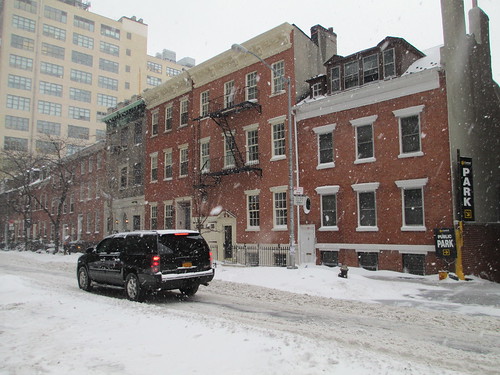 |
| Vandam St in a snowstorm: a contrast to the order beneath the streets |
The journey’s smoothness was a tribute to the virtues of
forward planning, teamwork and operational excellence that make for a
smoothly-running transit system. At street level, by contrast, a rental truck
whose driver had got it stuck on a pile of snow was blocking the street,
holding up a snow plough.
Yet, just the day before, it occurred to me, I’d been raving
about how magnificently satisfying my cycle ride to work had been. I’d braved
well-below-freezing temperatures and persisting patches of ice and snow to ride
to work on both Tuesday and Wednesday, enjoying the challenge of the
unpredictable conditions and taking in magnificent views of the city spread out
before me.
Wasn’t there a contradiction, I thought to myself, about my
two positions? If I enjoyed using perhaps the most individualistic of
mechanised transport methods – the bicycle – wasn’t it odd I also admired such
an obviously shared form of transport as the subway? Moreover, it occurred to
me, why wasn’t I alone in my shared enthusiasm? Why did so many of the cyclists
and cycling advocates I knew have a decided preference for subways and buses
over cars in conditions when they couldn’t get about by bike?
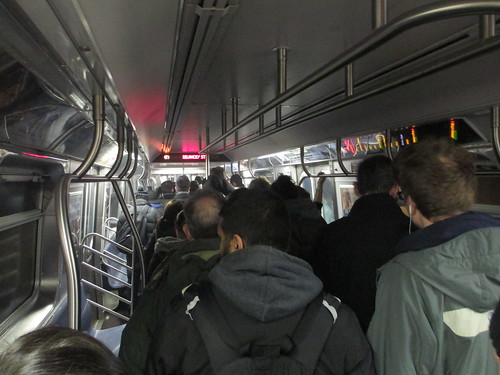 |
| Trying to leave an F Train when the track ahead is on fire. I can tell you what it felt like - just be grateful I can't make you smell the acrid smoke. |
I should start answering those questions by making it clear
that not all – possibly not even most – of the subway journeys I’ve been forced
to take for weather reasons in recent weeks have evoked the warm feelings that
my trip on Thursday did. I’ve had plenty of long waits for trains and other
disruptions, including the two-hour journey home I mentioned in a previous post. Worst of all was my experience on the morning of February 3. After
unwisely guessing that the F Train to West
4th St would be my quickest route to SoHo , I found myself trapped underground for 40 minutes.
The live rail in the station ahead was on fire and power to our train was cut
while the fire department tackled it. I don’t especially recommend the
experience of standing in a confined space with emergency lighting, no
air-conditioning and a growing smell of acrid smoke in the air.
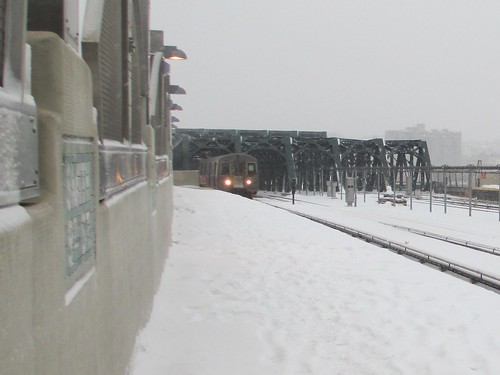 |
| A G Train on a snowy day. My background tells me it took teamwork and organisation to get this train running. |
I should also confess that part of my feeling for subway
systems stems from my background. My late father, who taught me to ride a bike,
devoted his whole working life to subways – first in London ,
then in Glasgow .
While my journey to work last Thursday might have seemed easy to me, I know that
subways do anything but run themselves. My dad, I recall, diverted the taxi
taking him and my mother to their 20th wedding anniversary dinner to
the subway depot. A train had derailed at a critical point and he wasn’t going
to relax until he was sure it was on its way to being put back.
I associate the New York
subway also with my grandfather, who visited New York as a seafarer in the 1920s and told
us wide-eyed children decades later about the marvels of express and local
trains and the other complexities of the subway system.
As I spot some complicated bit of lineside equipment or work
out some intricacy of the New York
City subway system’s workings, I often feel a sharp
pang at not being able to share it with my father, who died in 2002. “My train
was diverted over the disused express tracks, dad!” “I got a good look at the
snowblowing train!”
But there are also plenty of things about transit systems that cyclists can appreciate even if they haven't got my back story, I think. While many motorists seem to view their car as
an extension of private space, I recognise clearly when I’m on my bike that I’m
involved in a complex social interaction. The difficulty of communicating with
other drivers is one of the things I least like about driving. It’s less of a
stretch for me than for a driver or habitual taxi user to have to negotiate the
scores of interpersonal transactions involved in using busy subway trains.
 |
| Copenhagen's cycle rush hour: they could have got a nice train instead, lucky people. |
It’s certainly no coincidence that cities that are good
for cycling also tend to have good public transport. Copenhagen has a magnificent driverless metro
system as well as good suburban S-Trains. Amsterdam
has a formidable tram and suburban rail network. In the US , Portland ,
Oregon Washington , DC , also
enjoys a combination of relatively good cycling conditions and good public
transit (even if the Washington
metro’s train frequency and reliability could do with improvement). The careful
planning and forward thinking required to build a good public transit network
also tend to produce the kind of civic-minded thinking that prompts cities to curb car traffic, police streets well and put in good cycling facilties.
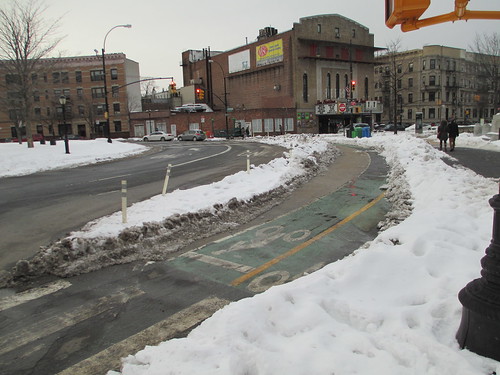 |
| A partly-cleared bike lane: cyclists and transit users have both been getting spotty service |
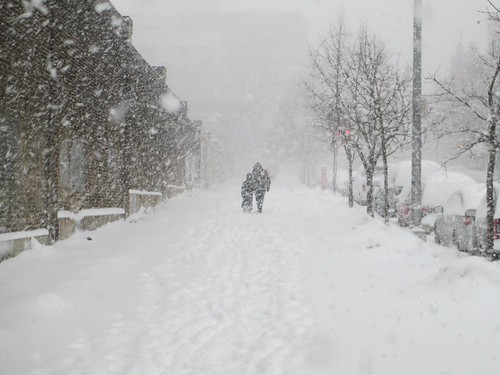 |
| There are days when, sorry, even I can't cycle |
The spotty service I’ve experienced in recent weeks in New York is consequently an excellent summary of how the city is faring in both cycling and public
transport. There are moments when the smoothness and progress from the worst
times seems like a miracle. There are others when the main improvements from
the city’s darkest days seem to be that the ageing trains are no longer covered
with graffiti. The fire that kept me stuck underground isn't the only one I've encountered lately.
The subway's challenges regularly remind me that I prefer to cycle when I can. I also enjoy the exercise, the fresh air, the views
from the Manhattan
Bridge and cycling's
But, on days when the weather gives me no choice, the subway
reminds me of the excitement I still feel at living in this mad experiment of a
city, scattered on the islands and peninsulas around New York Harbour
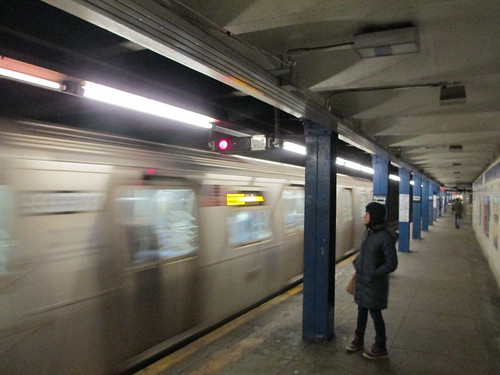 |
| "This is a World Trade Center-bound E local train!" - words that still sound oddly exciting to me. |
Even the littlest detail of the journey can send that
welling up in me. There’s the rattling of an express train through a local
station, its lights flashing as they pass the support pillars. There are the
names that evoke a thousand novels, songs and films. There’s the bizarre mixture
of all kinds of cultures and classes one finds crammed onto many subway cars.
All are summed up sometimes in the announcements that squawk
out over the public address as I step onto the train.
“This is a Manhattan-bound A train,” I hear with childish
excitement. “Next stop: High
St-Brooklyn Bridge
I've been to NYC a few times and the subway system there always impresses me. Unlike Stockholm's somewhat "sterile" and relatively tiny system, the NYC subway just oozes "age and wisdom". Like a wrinkled old person who has a ton of stories to tell.. :-)
ReplyDeleteDmitri,
DeleteThanks for the comment.
The express and local system, the 24-hour operation and many other aspects of the New York subway's operation are all marvels.
However, I will mention one thing about the Stockholm system. My father visited Stockholm to see your subway in the 1970s, during planning for the Glasgow Subway's modernisation and was hugely impressed with the station where the station cavern is unlined and there's paint straight on the bare rock. There's nothing quite like that in New York.
All the best,
Invisible.
Hi,
DeleteYeah there are several stations like that actually now, and I find that to be a clever way to save money without any drawbacks, all the while looking pretty cool :-)
But the subway has not seen any expansion since 1994, and it's been badly needed.
And my biggest pet peeve: bikes are never allowed.
And it just doesn't have that atmosphere of New Yorks subway, I'm not sure what it is really...
Dmitri,
DeleteWell, modern metros are more bland, standardised and efficient. The New York subway isn't even standardised among the different lines built by the three different organisations that built the system.
The bikes thing is annoying. One's allowed to take a bike on the New York subway outside peak hours. It's just generally very unpopular if one does it...
All the best,
Invisible.
Dmitri,
ReplyDeleteMontreal used to have a bike ban. To show how ridiculous it was, protesters took all kinds of other things that were as large as a bike onto the subway. Bikes are now allowed on the Montreal subway.
Which, btw, has rubber tyres. Very quiet.
Kevin,
DeleteThanks for the comment. Bikes are allowed on the NYC subway, outside peak hours. But the dirty looks that any cyclist who brings his bike on the subway gets are a pretty powerful deterrent to ever using that right.
All the best,
Invisible.
I'll take dirty looks over a ban any day.
DeleteAs for protests, Stockholm residents are way too passive for that kind of event, and also the Swedish bureaucracy is way too complex... We're working on it through political channels though.
Dear Invisible,
ReplyDeleteYou make an interesting connection between the cyclist and their will to engage public transport which was lived out through a recent experience. A visit to Edinburgh concluded with a trip to the airport with my manager. The airport bus is cheap and efficient but the preference was the taxi at three times the cost. It seemed that their personal preference was the reason, perhaps their experience of living life in a car made them unsure of the bus.
I appreciate places & people, to have an immersive experience as I travel and I find that bicycle or public transport will give that opportunity where as the car removes it. So I wonder; did I always appreciate what was around me or has being a cyclist taught me that?
Doug,
DeleteI frequently have arguments such as that if I ever have to travel with colleagues, I favour public transport.
I think people think being in a private motor vehicle gives them control of a situation. The fact that so many people think that means, of course, in many circumstances that none of them does.
As for temperament, I think I became a cyclist because of a pre-existing inclination - but that being a cyclist has made the inclination more profound. Does that sound like what's happened to you?
All the best,
Invisible.
I think that part of the reason cyclists are more likely to use public transportation is that they have been able to escape the car mentality and are no longer blindly following what car culture has taught. You start to realize that you are free to choose the right tool for the job. You start to evaluate the costs and benefits of each means of transportation.
DeleteI recently rode the NYC subway while there at the Youth Bike Summit. A woman came through one of the connecting doors talking to herself or to someone on an unseen phone connection. She sat across from us, and without comment or provocation spit across the aisle at the feet of the man to my right. The man to my left broke up laughing in disbelief saying "That is so NASTY" out loud over and over. I just kept to myself -- a true New Yorker at that moment.
ReplyDeleteIn DC we are also allowed bikes during non-peak hours. I hate that -- when I need to go to the city, I need to go during peak hours, and living out in the suburbs, taking my bike the whole way means 1.5 hours added each way. I can't wait until our new station opens with the 200+ secured bike room!
SouthLakes,
DeleteI hope you enjoyed the bike summit. I'm sorry we didn't provide better weather. Sadly, the subway in cold weather ends up sheltering a disproportionate number of those with mental health and other problems.
As it happens, I was down last week in Washington, showing the family the sights and we were impressed with your metro, albeit not with the train frequencies. I noticed there was already signage for the new silver line (which I'm guessing is the one near you) so I hope they get it open soon.
All the best,
Invisible.
So we traded places? Sorry about that frequency thing. They figure tourists will put up with weekend delays while they're doing maintenance. And yes, we can't WAIT for the Silver line!
DeleteBy the way, this morning, Diane Rehm show, Doug Most talking about his new book about the Subways -- dug (get it, Doug?) in Boston and NY in the 19th century. The Race Underground. Absolutely fascinating listening. (I was trapped in car to take kid back to college)